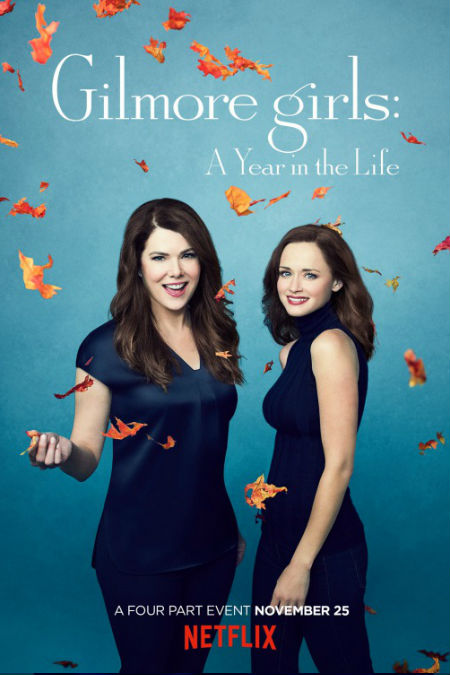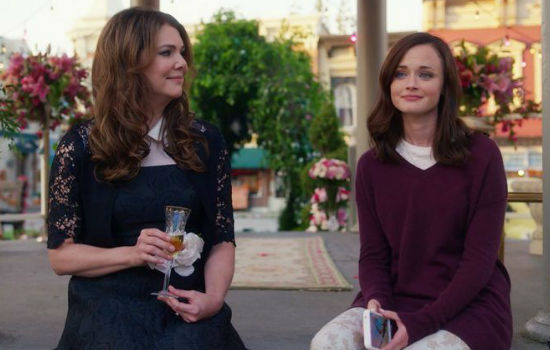
So that was quite a year wasn’t it?
Admittedly it was distilled down to 4 x 90 minute episodes but given the ups and downs we endured along with Lorelei (Lauren Graham), Rory (Alexis Bledel) and Emily (Kelly Bishop) it feels like an entire year had passed for the Gilmore Girls, especially after a particularly bleak, deeply reflective Summer.
Thankfully, things are looking up in “Fall” – clearly Reverse Land has taken over here with the bad things happening when things are bright and light and things looking up as temperatures plunge and gloominess descends – despite Lorelei having left Luke (Scott Patterson) behind to go Wild on the Pacific Coast in California.
Yep Lorelei is going to find herself, along with half the female population of the United States who all exit their motel rooms wearing insanely large backpacks in the sort of choreographed Mel Brooks-ian piss take that would have made Cecil B de Mille proud for entirely different reasons.
It’s a gentle dig at the commodification of going Wild – book or TV? That’s the delineator between the two groups, influencing how you go back to nature apparently – with everyone adding in extra little luxuries that probably go against the spirit of the undertaking.
Even so, Lorelei is going to give her three weeks in the wilds of California a red hot go – Luke of course is convinced this all means she’s leaving him; not such a crazy idea with Lorelei being quizzed by her Wild-mates one night about why she was undertaking the hike – Marriage busted? Awful kids? Drug addiction? – but after a mix-up with the ranger (played by real life boyfriend Peter Krauss) over her misplaced permit, she temporarily gives up and going to get coffee at a nearby locked gas station.
Now, it may not look like road to Damascus epiphany central but behind the gas station Lorelei finds a jaw-droppingly beautiful vista, inspiring a realisation of what matters to her – Luke duh! Hello wedding bells! – and one of the most touching scenes I’ve ever witnessed in any show when she calls her mum and recounts a heartbreakingly beautiful memory of her dad being there for her at one of the lowest points in her teenage life.
Emily is touched, Lorelei is crying and yes so was I and I’m pretty anyone else who’s ever lost anyone and been struck by memories coming at the most unexpected of times.
So with the whole Wild schtick a bust – in the strictest sense anyway; in every other respect, mission accomplished! – Lorelei flies home, asks Luke to marry her (he has a ring ready to do the same so score!), eats pizza, gets fitted for a wedding dress and marries in impromptu fashion one night because the town’s Reverend is up late hosting bingo.
Phew! It is quirky, heartfelt, beautiful and meaningful all at once, a reasonably standard kind of end to things to which Gilmore Girls gave so much more emotional resonance, especially after Lorelei’s crisis of faith.

Lorelei isn’t alone in her crisis of faith.
Rory, who mysteriously has gone from the buttoned-up, list-making, can-do girl of her late teens and twenties to an all-across-the-shop early thirties freelance journalist who’s lost her way, professionally and personally, is neck deep in one of her own.
Some reviewers have criticised that they see these changes in Rory as a character betrayal but the fact is that plenty of people go from got-it-all-together early twenties person to no-I-don’t-not-at-all early thirties person simply because life is a take no prisoners kind off deal and it’s only when we’re out in the real world that we begin to understand that our plans ultimately mean nothing.
I like that Gilmore Girls is brutally honest about this, and doesn’t leave Rory as the infallible golden child who can do no wrong; clearly she is capable of making some very bad choices such as continuing things with Logan long after it is emotionally sane to do so.
But even there, it is clear she loves him and is hanging in there in the hope that affairs of the heart can triumph over dynastic responsibilities (they don’t which is a relief since too many perfectly happy endings would be too much for even the Gilmore Girls).
What’s pleasing about Rory’s storyline is that her crisis of faith isn’t tied off nice and neatly.
At the end, when the immortal four words are spoken – SPOILER!!! “Mom?” “Yeah?” “I’m pregnant.” *and fade* – many balls are still up in the air, although Lorelai has consented to the Gilmore Girls book being written at least.
The narrative here has been seen by some as too open-ended and unsatisfying but that’s life to a tee – you don’t always get your happy ending, not even when the Life and Death Brigade show and whisk you off to a magical night of rooftop golf, purloined groceries, tango clubs and B & Bs; it reflects the fact that things don’t always resolve in the manner of fairytales and American sitcoms, and is realistic and far more affecting than some trite wrapping up of events.
One person who does get a happy ending of sorts – though happy is hardly the word she would use with Richard (Edward Herrmann) gone and life a pale imitation of its former self – is Emily who calls the Daughters of the American Revolution for the queens of bullshit artifice that they are and storms out of the meeting and her old life, declaring “This whole thing is dead to me anyhow. It died with Richard.”
This is Emily, real, raw and uncensored, a woman who understands all too well that life will never be the same again and she can either pretend it’s all the same or move on.
Which she does, selling the house in Hartford, buying one on Nantucket Island and taking everyone including Berta up there to make a whole new life for herself, one that includes toasting talks at the local whaling museum, where she applies tad too much gusto and graphicness to her presentations.
She’s still missing Richard terribly of course and one scene where she gently touches his face in a painting she had done of him – right size this time! – is deeply affecting and intensely moving.
This is a side we have rarely seen of Emily but in the after wash of intense grief it all makes perfect sense and Gilmore Girls is to be applauded for letting grief be given its full expression and not tidied up in some glib and inauthentic fashion.
So in “Fall” things both end and begin, with life continuing on as it always does in incomplete fits and starts, half-realised measures and hopes and dreams and yes some happy endings, but all on the understanding that even in delightfully storied Connecticut towns like Stars Hollow, life isn’t ever really neatly tied off and continues on whether we’re ready for it or not.
For a full recap of “Fall”, go HERE and for pop culture references go HERE.